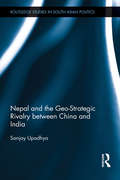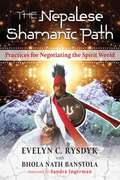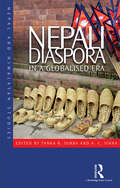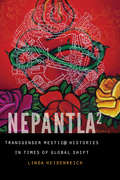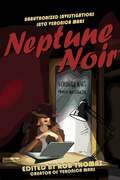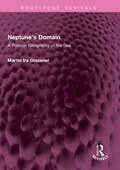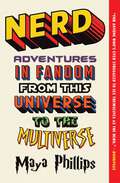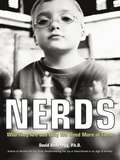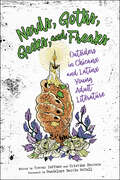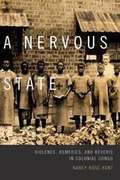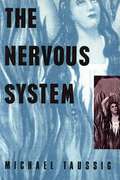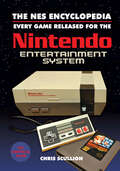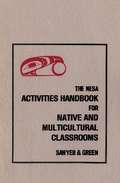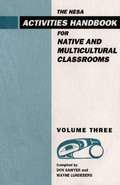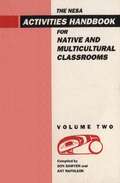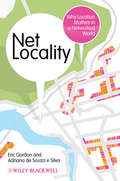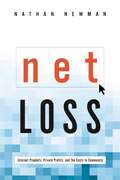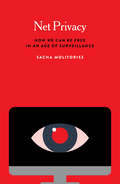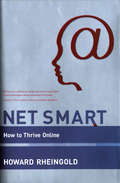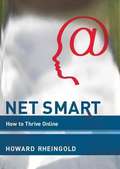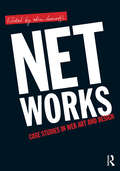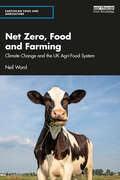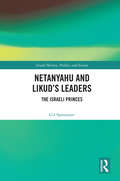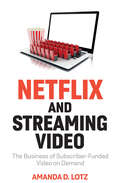- Table View
- List View
Nepal and the Geo-Strategic Rivalry between China and India (Routledge Studies in South Asian Politics)
by Sanjay UpadhyaThe importance of the Himalayan state of Nepal has been obscured by the international campaign to free Tibet and the vicissitudes of the Sino-Indian rivalry. This book presents the history of Nepal’s domestic politics and foreign relations from ancient to modern times. Analysing newly declassified reports from the United States and Britain, published memoirs, oral recollections and interviews, the book presents the historical interactions between Nepal, China, Tibet and India. It discusses how the ageing and inevitable death of the 14th Dalai Lama, the radicalization of Tibetan diaspora and the ascendancy of the international campaign to free Tibet are of increasing importance to Nepal. With its position between China and India, the book notes how the focus could shift to Nepal, with it being home to some 20,000 Tibetan refugees and its chronic political turmoil, deepened by the Asian giants’ rivalry. Using a chronological approach, the past and present of the rivalry between China and India are studied, and attempts to chart the future are made. The book contributes to a new understanding of the intricate relationship of Nepal with these neighbouring countries, and is of interest to students and scholars of South Asian studies, politics and international relations.
The Nepalese Shamanic Path: Practices for Negotiating the Spirit World
by Evelyn C. Rysdyk Bhola Nath Banstola Sandra IngermanAn experiential guide to the shamanic spiritual practices of the Himalayas shared by a 27th-generation Nepalese shaman • Presents step-by-step, illustrated instructions for authentic Himalayan shamanic practices, including physical and spiritual healing, shamanic journeys, and ceremonies • Includes exercises to meet the ancestors in your shamanic lineage, techniques to use your voice as a shamanic tool, and practices for negotiating the spirit world safely • Details shamanic chants and rituals, how to create an altar, and the sacred objects of the shaman, along with exercises and techniques for using them properly There are few areas of our world where shamanic traditions have been preserved in their original context and form. Nepal is one of these rare and special places. In the shadow of the Himalayas Nepalese shamans, known as dhamis or jhankris, are still consulted for healing and divination, as well as for providing comfort and maintaining harmony. Following the devastating earthquake in Nepal in 2015, shamanic teacher Evelyn Rysdyk and 27th-generation dhami Bhola Nath Banstola decided it was time to safeguard Nepalese shamanic knowledge for future generations by recording the practices in a book. With this comprehensive, experiential guide to the ancient spiritual traditions of Nepal, Rysdyk and Banstola present step-by-step instructions for authentic Himalayan shamanic practices, including techniques for physical and spiritual healing, shamanic journeys, and advanced ceremonies, such as the Kalchakra Katne, a shamanic ritual for removing toxic energies from an individual. They include exercises to help you meet the ancestors in your shamanic lineage, techniques to use your voice as a shamanic tool, and practices for negotiating the spirit world safely. They detail shamanic chants and rituals, how to create an altar, and how to use the sacred objects of the dhami/jhankri, including the mala, the magic mirror, the drum, and the Khurpa, the shaman’s magic dagger. Rysdyk and Banstola also examine the importance of Nepalese cosmology in shamanic ritual and spiritual deities such as Hanuman, Garuda, and the Nagas. Illustrated with photos and Rysdyk’s artwork, the book also explores the history of Nepal, its culture and myths, and the different ways Nepalese shamans serve their communities. Written specifically to share the traditional Himalayan shamanic method with the Western world, this guide not only preserves these ancient teachings but also reveals how they are still relevant in the modern world.
Nepali Diaspora in a Globalised Era (Nepal and Himalayan Studies)
by Tanka B. Subba A. C. SinhaThis is one of the first books to explore Nepali diaspora in a global context, across India and other parts of South Asia, Southeast Asia, Europe, and Australia. It discusses the social, political and economic status and aspirations of the Nepali community worldwide. The essays in the volume cover a range of themes including belonging and identity politics among Nepalese migrants, representation of Indian Nepalis in literature, diasporic consciousness, forceful eviction and displacement, social movements, and ritual practices among migrant communities. Drawing attention to the lives of Nepali emigrants, the volume presents a sensitive and balanced understanding of their options and constraints, and their ambivalences about who they are. This work will be invaluable to scholars and students of Nepal studies, area studies, diaspora and migration studies, social anthropology, cultural studies and literature.
Nepantla Squared: Transgender Mestiz@ Histories in Times of Global Shift (Expanding Frontiers: Interdisciplinary Approaches to Studies of Women, Gender, and Sexuality)
by Linda HeidenreichNepantla Squared maps the lives of two transgender mestiz@s, one during the turn of the twentieth century and one during the turn of the twenty-first century, to chart the ways race, gender, sex, ethnicity, and capital function differently in different times. To address the erasure of transgender mestiz@ realities from history, Linda Heidenreich employs an intersectional analysis that critiques monopoly and global capitalism. Heidenreich builds on the work of Gloria Anzaldúa&’s concept of nepantleras, those who could live between and embody more than one culture, to coin the term nepantla², marking times of capitalist transition where gender was also in motion. Transgender mestiz@s, too, embodied that movement. Heidenreich insists on a careful examination of the multiple in-between spaces that construct lives between cultures and genders during in-between times of shifting empire and capital. In so doing, they offer an important discussion of race, class, nation, and citizenship centered on transgender bodies of color that challenges readers to rethink the way they understand the gendered social and economic challenges of today.
Neptune Noir: Unauthorized Investigations into Veronica Mars
by Rob ThomasNeptune Noir is a collection of essays on the hit drama Veronica Mars, and is not authorized by CW, the creators or producers of Veronica Mars, or any entity associated with the show. More than just a high school drama, Veronica Mars is a smart and savvy teen detective show that offers complex mysteries and rapier wit, engaging social commentary, and noir sensibilities—with the occasional murder thrown in for good measure. This collection, edited by the creator and executive producer of the show, offers supreme insight into the class struggles and love stories of the series. Essays by top writers intelligently address a multitude of questions, such as Is Veronica a modern-day vigilante? Why is a show that features rape, potential incest, and a teen girl outsmarting local authorities so popular with America's conservative population? and Why is Veronica and Logan's relationship the most important story-driving factor in the show?
Neptune's Domain: A Political Geography of the Sea (Routledge Revivals)
by Martin Ira GlassnerFirst published in 1990, Neptune’s Domain is organized around one unifying theme: the geographic aspects of the new Law of the Sea as expressed primarily in the United Nations Convention on the Law of the Sea. The first two chapters provide essential background information. Chapters 3 through 9 explain relevant provisions of the Convention. The next two chapters cover topics excluded from the Convention, and the last three chapters are more analytical and future-oriented. All students and scholars concerned with the human use of the marine environment will welcome this book, whether they be geographers, political scientists or lawyers.
Nerd: Adventures in Fandom from This Universe to the Multiverse
by Maya PhillipsIn the vein of You&’re Never Weird on the Internet (Almost) and Black Nerd Problems, this witty, incisive essay collection from New York Times critic at large Maya Phillips explores race, religion, sexuality, and more through the lens of her favorite pop culture fandoms.From the moment Maya Phillips saw the opening scroll of Star Wars, Episode V: The Empire Strikes Back, her childhood changed forever. Her formative years were spent loving not just the Star Wars saga, but superhero cartoons, anime, Buffy the Vampire Slayer, Harry Potter, Tolkien, and Doctor Who—to name just a few. As a critic at large at The New York Times, Phillips has written extensively on theater, poetry, and the latest blockbusters—with her love of some of the most popular and nerdy fandoms informing her career. Now, she analyzes the mark these beloved intellectual properties leave on young and adult minds, and what they teach us about race, gender expression, religion, and more—especially as fandom becomes more and more mainstream. Spanning from the 90s through to today, Nerd is a collection of cultural criticism essays through the lens of fandom for everyone from the casual Marvel movie watcher to the hardcore Star Wars expanded universe connoisseur. It&’s for anyone who&’s ever wondered where they fit into the narrative or if they can be seen as a hero—even of their own story.
Nerds: How Dorks, Dweebs, Techies, and Trekkies can save America and why they might be our Last Hope
by David Anderegg"Anderegg's clear-eyed look at a damaging cultural truism does nerds and jocks-all Americans, really-a service. " (The Washington Post). Thick glasses, socially awkward, a math whiz with a pocket protector- everyone knows what a nerd is. But where did this stereotype come from? Children aren't born knowing what a "nerd" or "geek" is, so why do they know by the age of five or six that they don't want to be one? In this revised and updated paperback edition of his thought-provoking book, family psychotherapist and psychology professor David Anderegg reveals how the systematic disparagement of "nerds" in our culture is bad for our children and even worse for America. In Nerds, Anderegg examines why science and engineering have become socially poisonous disciplines, why adults wink at the derision of "nerdy" kids, and what the cost of this rising tide of anti- intellectualism is to both our children and our nation. Drawing upon education research, psychological theory, and his own interviews with nerdy and non-nerdy kids alike, Anderegg argues that in order to prepare rising generations to compete in the global marketplace, we need to revisit how we think about "nerds. " .
Nerds, Goths, Geeks, and Freaks: Outsiders in Chicanx and Latinx Young Adult Literature (Children's Literature Association Series)
by Trevor Boffone and Cristina HerreraWinner of the Children’s Literature Association’s 2022 Edited Book AwardContributions by Carolina Alonso, Elena Avilés, Trevor Boffone, Christi Cook, Ella Diaz, Amanda Ellis, Cristina Herrera, Guadalupe García McCall, Domino Pérez, Adrianna M. Santos, Roxanne Schroeder-Arce, Lettycia Terrones, and Tim Wadham In Nerds, Goths, Geeks, and Freaks: Outsiders in Chicanx and Latinx Young Adult Literature, the outsider intersects with discussions of race, ethnicity, gender, and sexuality. The essays in this volume address questions of outsider identities and how these identities are shaped by mainstream myths around Chicanx and Latinx young people, particularly with the common stereotype of the struggling, underachieving inner-city teens. Contributors also grapple with how young adults reclaim what it means to be an outsider, weirdo, nerd, or goth, and how the reclamation of these marginalized identities expand conversations around authenticity and narrow understandings of what constitutes cultural identity. Included are analysis of such texts as I Am Not Your Perfect Mexican Daughter, Shadowshaper, Swimming While Drowning, and others. Addressed in the essays are themes of outsiders in Chicanx/Latinx children’s and young adult literature, and the contributors insist that to understand Latinx youth identities it is necessary to shed light on outsiders within an already marginalized ethnic group: nerds, goths, geeks, freaks, and others who might not fit within such Latinx popular cultural paradigms as the chola and cholo, identities that are ever-present in films, television, and the internet.
A Nervous State: Violence, Remedies, and Reverie in Colonial Congo
by Nancy Rose HuntIn A Nervous State, Nancy Rose Hunt considers the afterlives of violence and harm in King Leopold's Congo Free State. Discarding catastrophe as narrative form, she instead brings alive a history of colonial nervousness. This mood suffused medical investigations, security operations, and vernacular healing movements. With a heuristic of two colonial states--one "nervous," one biopolitical--the analysis alternates between medical research into birthrates, gonorrhea, and childlessness and the securitization of subaltern "therapeutic insurgencies." By the time of Belgian Congo's famed postwar developmentalist schemes, a shining infertility clinic stood near a bleak penal colony, both sited where a notorious Leopoldian rubber company once enabled rape and mutilation. Hunt's history bursts with layers of perceptibility and song, conveying everyday surfaces and daydreams of subalterns and colonials alike. Congolese endured and evaded forced labor and medical and security screening. Quick-witted, they stirred unease through healing, wonder, memory, and dance. This capacious medical history sheds light on Congolese sexual and musical economies, on practices of distraction, urbanity, and hedonism. Drawing on theoretical concepts from Georges Canguilhem, Georges Balandier, and Gaston Bachelard, Hunt provides a bold new framework for teasing out the complexities of colonial history.
The Nervous System
by Michael TaussigIn a series of intriguing essays ranging over terror, State fetishism, shamanic healing in Latin America, homesickness, and the place of the tactile eye in both magic and modernity, anthropologist Michael Taussig puts into representational practice a curious type of engaged writing. Based on a paranoiac vision of social control and its understanding as in a permanent state of emergency leaving no room for contemplation between signs and things, these essays hover between story-telling and high theory and thus create strange new modes of critical discourse. The Nervous System will appeal to writers, scholars, artists, film makers, and readers interested in critical theory, aesthetics, and politics.
The NES Encyclopedia: Every Game Released for the Nintendo Entertainment System
by Chris ScullionA comprehensive, colorful guide to every game ever released on the classic Nintendo Entertainment System. One of the most iconic video game systems, the NES is credited with saving the American video games industry in the early 1980s. The NES Encyclopedia is the first ever complete reference guide to every game released on the Nintendo Entertainment System, Nintendo&’s first industry-defining video game system. As well as covering all 714 officially licensed NES games, the book also includes more than 160 unlicensed games released during its lifespan, giving for the first time a definitive history of this important console's full library. Written by a retro gaming expert with 30 years of gaming experience and a penchant for bad jokes, TheNES Encyclopedia promises to be both informative and entertaining. The NES continues to enjoy a strong cult following among Nintendo fans and gamers in general with wide varieties of officially licensed merchandise proving ever popular. Nintendo&’s most recent console, the Switch, is the fastest selling video game console of all time in the United States and Japan. Nintendo launched a variety of classic NES games for download on the system, meaning a new audience of gamers is due to discover the NES for the first time if they have not already. Praise for The NES Encyclopedia &“As a catalog of all 876 NES games, this work is unique in its breadth of coverage and will be of great interest to old-school video gamers and collectors.&” —Booklist &“A definitive resource that is more than worthy of the title &‘Encyclopedia.&’ &” —Nintendo World Report
NESA: Volume 1
by Howard Green Don SawyerThis is the first of three volumes of educational activities for use in First Nations and multicultural classrooms. The activities stress the importance of culture in students' lives, and teaches them basic personal and community-related skills so they may become more self-reliant and culturally responsible.The Native Education Services Associates are a group of teaching professionals with extensive experience in Native and multicultural education. Their materials provide educators with meaningful and appropriate culturally-based learning resources and are also designed to enhance understanding between ethnic and cultural groups.
NESA: Activites Handbook for Native and Multicultural Classrooms, Volume 3
by Don Sawyer Wayne LundebergThis is the third of three volumes of educational activities for use in First Nations and multicultural classrooms. The activities stress the importance of culture in students' lives, and teaches them basic personal and community-related skills so they may become more self-reliant and culturally responsible.The Native Education Services Associates are a group of teaching professionals with extensive experience in Native and multicultural education. Their materials provide educators with meaningful and appropriate culturally-based learning resources and are also designed to enhance understanding between ethnic and cultural groups.
NESA: Activites Handbook for Native and Multicultural Classrooms, Volume 2
by Don Sawyer Art NapoleonThis is the second of three volumes of educational activities for use in First Nations and multicultural classrooms. The activities stress the importance of culture in students' lives, and teaches them basic personal and community-related skills so they may become more self-reliant and culturally responsible.The Native Education Services Associates are a group of teaching professionals with extensive experience in Native and multicultural education. Their materials provide educators with meaningful and appropriate culturally-based learning resources and are also designed to enhance understanding between ethnic and cultural groups.
Net Locality
by Adriana de Souza e Silva Eric GordonThe first book to provide an introduction to the new theory of Net Locality and the profound effect on individuals and societies when everything is located or locatable. Describes net locality as an emerging form of location awareness central to all aspects of digital media, from mobile phones, to Google Maps, to location-based social networks and games, such as Foursquare and facebook.Warns of the threats these technologies, such as data surveillance, present to our sense of privacy, while also outlining the opportunities for pro-social developments.Provides a theory of the web in the context of the history of emerging technologies, from GeoCities to GPS, Wi-Fi, Wiki Me, and Google Android.
Net Loss: Internet Prophets, Private Profits, and the Costs to Community
by Nathan NewmanHow has the Internet been changing our lives, and how did these changes come about? Nathan Newman seeks the answers to these questions by studying the emergence of the Internet economy in Silicon Valley and the transformation of power relations it has brought about in our new information age. Net Loss is his effort to understand why technological innovation and growth have been accompanied by increasing economic inequality and a sense of political powerlessness among large sectors of the population. Newman first tells the story of the federal government’s crucial role in the early development of the Internet, with the promotion of open computer standards and collaborative business practices that became the driving force of the Silicon Valley model. He then examines the complex dynamic of the process whereby regional economies have been changing as business alliances built around industries like the Internet replace the broader public investments that fueled regional growth in the past. A radical restructuring of once regionally focused industries like banking, electric utilities, and telephone companies is under way, with changes in federal regulation helping to undermine regional planning and the power of local community actors. The rise of global Internet commerce itself contributes to weakening the tax base of local governments, even as these governments increasingly use networked technology to market themselves and their citizens to global business, usually at the expense of all but their most elite residents. More optimistically, Newman sees an emerging countertrend of global use of the Internet by grassroots organizations, such as those in the antiglobalization movements, that may help to transcend this local powerlessness.
Net Privacy: How We Can Be Free in an Age of Surveillance
by Sacha MolitoriszIn our digital world, we are confused by privacy – what is public, what is private? We are also challenged by it, the conditions of privacy so uncertain we become unsure about our rights to it. We may choose to share personal information, but often do so on the assumption that it won't be re-shared, sold, or passed on to other parties without our knowing. In the eighteenth century, philosopher Jeremy Bentham wrote about a new model for a prison called a Panopticon, where inmates surrounded the jailers, always under watch. Have we built ourselves a digital Panopticon? Are we the guards or the prisoners, captive or free? Can we be both? When Kim Kardashian makes the minutiae of her life available online, which is she? With great rigour, this important book draws on a Kantian philosophy of ethics and legal frameworks to examine where we are and to suggest steps – conceptual and practical – to ensure the future is not dystopian. Privacy is one of the defining issues of our time; this lively book explains why this is so, and the ways in which we might protect it.
Net Privacy: How We Can Be Free in an Age of Surveillance
by Sacha MolitoriszIn our digital world, we are confused by privacy – what is public, what is private? We are also challenged by it, the conditions of privacy so uncertain we become unsure about our rights to it. We may choose to share personal information, but often do so on the assumption that it won't be re-shared, sold, or passed on to other parties without our knowing. In the eighteenth century, philosopher Jeremy Bentham wrote about a new model for a prison called a Panopticon, where inmates surrounded the jailers, always under watch. Have we built ourselves a digital Panopticon? Are we the guards or the prisoners, captive or free? Can we be both? When Kim Kardashian makes the minutiae of her life available online, which is she? With great rigour, this important book draws on a Kantian philosophy of ethics and legal frameworks to examine where we are and to suggest steps – conceptual and practical – to ensure the future is not dystopian. Privacy is one of the defining issues of our time; this lively book explains why this is so, and the ways in which we might protect it.
Net Smart: How to Thrive Online (The\mit Press Ser.)
by Howard RheingoldA media guru shows us how to use social media intelligently, humanely, and, above all, mindfully.Like it or not, knowing how to make use of online tools without being overloaded with too much information is an essential ingredient to personal success in the twenty-first century. But how can we use digital media so that they make us empowered participants rather than passive receivers, grounded, well-rounded people rather than multitasking basket cases? In Net Smart, cyberculture expert Howard Rheingold shows us how to use social media intelligently, humanely, and, above all, mindfully. Mindful use of digital media means thinking about what we are doing, cultivating an ongoing inner inquiry into how we want to spend our time. Rheingold outlines five fundamental digital literacies, online skills that will help us do this: attention, participation, collaboration, critical consumption of information (or "crap detection"), and network smarts. He explains how attention works, and how we can use our attention to focus on the tiny relevant portion of the incoming tsunami of information. He describes the quality of participation that empowers the best of the bloggers, netizens, tweeters, and other online community participants; he examines how successful online collaborative enterprises contribute new knowledge to the world in new ways; and he teaches us a lesson on networks and network building. Rheingold points out that there is a bigger social issue at work in digital literacy, one that goes beyond personal empowerment. If we combine our individual efforts wisely, it could produce a more thoughtful society: countless small acts like publishing a Web page or sharing a link could add up to a public good that enriches everybody.
Net Smart: How to Thrive Online
by Howard RheingoldLike it or not, knowing how to make use of online tools without being overloaded with too much information is an essential ingredient to personal success in the twenty-first century. But how can we use digital media so that they make us empowered participants rather than passive receivers, grounded, well-rounded people rather than multitasking basket cases? In Net Smart, cyberculture expert Howard Rheingold shows us how to use social media intelligently, humanely, and, above all, mindfully. Mindful use of digital media means thinking about what we are doing, cultivating an ongoing inner inquiry into how we want to spend our time. Rheingold outlines five fundamental digital literacies, online skills that will help us do this: attention, participation, collaboration, critical consumption of information (or "crap detection"), and network smarts. He explains how attention works, and how we can use our attention to focus on the tiny relevant portion of the incoming tsunami of information. He describes the quality of participation that empowers the best of the bloggers, netizens, tweeters, and other online community participants; he examines how successful online collaborative enterprises contribute new knowledge to the world in new ways; and he teaches us a lesson on networks and network building. Rheingold points out that there is a bigger social issue at work in digital literacy, one that goes beyond personal empowerment. If we combine our individual efforts wisely, it could produce a more thoughtful society: countless small acts like publishing a Web page or sharing a link could add up to a public good that enriches everybody.
Net Works: Case Studies in Web Art and Design
by Xtine BurroughNet Works offers an inside look into the process of successfully developing thoughtful, innovative digital media. In many practice-based art texts and classrooms, technology is divorced from the socio-political concerns of those using it. Although there are many resources for media theorists, practice-based students sometimes find it difficult to engage with a text that fails to relate theoretical concerns to the act of creating. Net Works strives to fill that gap. Using websites as case studies, each chapter introduces a different style of web project--from formalist play to social activism to data visualization--and then includes the artists' or entrepreneurs' reflections on the particular challenges and outcomes of developing that web project. Scholarly introductions to each section apply a theoretical frame for the projects. A companion website offers further resources for hands-on learning. Combining practical skills for web authoring with critical perspectives on the web, Net Works is ideal for courses in new media design, art, communication, critical studies, media and technology, or popular digital/internet culture.
Net Zero, Food and Farming: Climate Change and the UK Agri-Food System (Earthscan Food and Agriculture)
by Neil WardThis book examines the implications of the net zero transition for food and farming in the UK and how these can be managed to avoid catastrophic climate change in the crucial decades ahead. For the UK to meet its international obligations for reducing greenhouse gas emissions, nothing short of a revolution is required in our use of land, our farming practices and our diet. Taking a historical approach, the book examines the evolution of agriculture and the food system in the UK over the last century and discusses the implications of tackling climate change for food, farming and land use, setting the UK situation in an international context. The chapters analyse the key challenges for this transition, including dietary change and food waste, afforestation and energy crops, and low-emission farming practices. This historical perspective helps develop an understanding of how our food, farming and land use system has evolved to be the way that it is, and draws lessons for how the agri-food system could evolve further to support the transition to net zero and avoid catastrophic climate change. Written in a clear and accessible style, this book will be essential reading to students and scholars of food, agriculture and the environment, as well as policymakers and professionals involved climate change policy and the agriculture and food industry.
Netanyahu and Likud’s Leaders: The Israeli Princes (Israeli History, Politics and Society)
by Gil SamsonovThis research discusses the second-generation Likud leaders, known as the Princes, who have dominated Israeli politics for most of the last three decades: their relations with their parents and the extent to which they have followed in (or diverged from) their footsteps. The main theme seeks to explore the unique, perhaps unprecedented, socio-political phenomenon of generational duplication in a western-type democracy. This volume examines the ways and means through which the disciples of Zionist leader Zeev Jabotinsky managed not only to maintain lasting control of their mentor's creation – to transform after Israel's establishment from a small opposition party into the country's dominant and ruling party – but also hand down this political pre-eminence to their descendants. Prime Minister Benjamin Netanyahu is the son of Ben-Zion Netanyahu, "foreign minister" of Jabotinsky's movement. President Reuven Rivlin is the son of resistance warrior Rachel Rivlin. MP Benny Begin is the son of Menachem Begin. Former Prime Minister Ehud Olmert, Tzipi Livni and many others were also part of those "Princes". A breakthrough in the world’s inter-generational research, the book is for readers interested in political science, sociology, and the politics of Israel and the Middle East.
Netflix and Streaming Video: The Business of Subscriber-Funded Video on Demand
by Amanda D. LotzNetflix and Streaming Video is the first book to provide a comprehensive foundation for understanding the business of subscriber-funded streaming video and its implications for the role of these services in culture. Drawing on Lotz&’s two decades of research, it highlights the similarities and differences among streaming video services (Netflix; Amazon) and video distribution technologies (broadcast; satellite; internet). Making a number of provocative and thought-provoking arguments, the book first reveals how the reliance on subscriber payment and video on demand produces different norms and strategies compared to previous video businesses. It then investigates Netflix and how its particular blend of characteristics distinguishes it from other subscriber-funded video on demand services. The author expertly shows that, by understanding the underlying economic and technological dynamics of these services (and their differences), it is possible to better assess the actions taken by the companies and what the future of video may encompass. The book is a must-read for students and scholars of Media and Communications Studies, as well as those wishing to learn more about Netflix and streaming video services.
